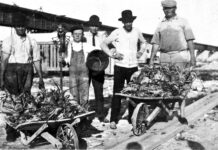Lemuel Otis, Monroe County’s First Sheriff?
For every prominent early Key West resident immortalized on buildings and street signs, scores of lesser-known residents go virtually unrecognized. One of these individuals is Lemuel Otis. In what may be the earliest record of Otis in Key West, an 1826 document identified him as master of the schooner Amanda Malvina. Like many who have come to the Florida Keys, it seems like he visited the island and decided to stay.
By 1828, Otis is referred to as Key West’s jailer. He was, apparently, only a part-time resident as the same year Otis is recorded as living on Indian Key and doing a little farming on nearby Tea Table Key.
Accounts of Otis would begin appearing in newspapers, repeatedly, in 1829. In one event, Charles Greene was indicted for resisting when Otis attempted to serve a legal paper. The event likely occurred in Key West. In another event that year, one that found Otis on the other end of the judicial spectrum, he was arrested for assault and battery on a man named Culling E. Arledge. According to Florida Territory documents, “There having been no writ issued in the cause, it is ordered by the Court that it be stricken off the docket and dismissed.”
On November 15, 1829, one newspaper account states that Otis was indicted for the crime of permitting Pely Messer and Henry Webb, prisoners in his custody as jailer, to escape. 1829 is also the year that the Monroe County Sheriff Office attributes Lemuel Otis as the county’s first sheriff. The circumstances surrounding that designation are a little fuzzy. As the formal position of sheriff is an elected position, the documentation asserting the fact has proven as elusive as a Skunk Ape. Certainly, he was affiliated with some degree of law enforcement. What is also clear is that he was not above the law and capable of being arrested.
For a variety of reasons, his name would continue to appear in newspaper accounts. One of the more notable instances was a declaration he made regarding his wife. Otis exchanged wedding vows with Henrietta in December 1834. The two were living on Indian Key, where Otis is said to have worked as a carpenter. It would prove a short-lived union. Born in Germany circa 1818 and a child (by today’s standards) at the time, there is no indication as to the source of her need to depart their marital bed.
On July 25, 1835, Mr. Otis filed the following public announcement in the Key West Register: “Whereas my wife Henrietta has quitted my bed and board, I hereby forewarn all persons from harboring or trusting her on my account, for I will not pay any debts of her contracting.”
When she left, Henrietta moved to Key West. She remarried to lighthouse keeper Benjamin Kerr in 1838. They would divorce, too, but she would continue to live on the island. She would die on Key West in 1901.
Back on Indian Key, Otis is listed in an 1836 Election Notion announcing the posts of Monroe County Clerk, Sheriff, and Coroner. The election was held on February 1, 1836. Three voting precincts were identified, one at each of the three major settlements: Key West, Indian Key, and Cape Florida. At Indian Key, the voting center was held at Jacob Housman’s general store. Residents Housman, Charles Howe, and Lemuel Otis served as inspectors.
While there are no references to Otis acting as the sheriff, he has been identified as a justice of the peace from 1836-1842. It is important to keep in mind that, as of 1836, Indian Key was no longer part of Monroe County. In terms of the island chain, Monroe County stopped at Bahia Honda. Above Bahia Honda, the islands had become part of the newly formed Dade County. It seems that if Otis was living in Dade County, he was likely serving the county of Dade and not Monroe.
With that idea in mind, according to Territorial Papers of the United States dated February 17, 1840, there is documentation identifying Lemuel Otis serving as the county sheriff, the Dade County Sheriff. Whether or not Otis formally served as the first Monroe County Sheriff or not, it has been documented that he served as, if not the first, then one of the first Dade County sheriffs.
Otis would barely survive 1840. In the early morning hours of August 7, 1840, he was sleeping in a small room above Jacob Housman’s general store. When Indians attacked the island during the Seminole War, Otis attempted to escape the store and was struck in the leg by a musket ball. Wounded, he managed to make his way to the island’s edge and climb into one of the Indian canoes. Loss of blood from the gunshot made him too weak to paddle, so the canoe just floated away until it was discovered the following day afloat by a Navy ship. Lemuel Otis made a full, though not lengthy, recovery. Eighteen months later, on March 2, 1842, he died for unrelated reasons.


























